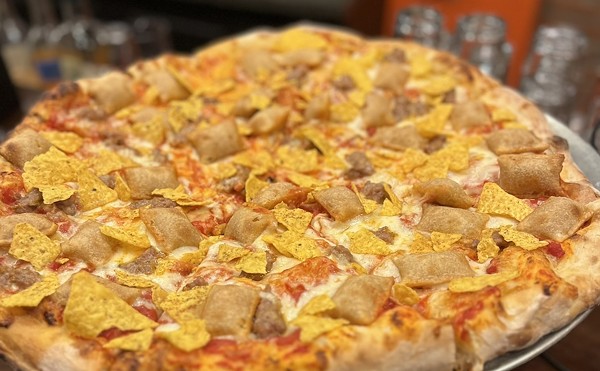They were talking about Wonton King, recently opened at the eastern edge of the as yet officially unnamed Little Asia district in the northwest corner of University City and part of Olivette. (For future historians, we'll hereby specify it as Olive Boulevard, bounded by North and South Boulevard on the east and Warson Road on the west, to include such places as Jade Garden and allow space for what promises to be continuing expansion. The heaviest concentration today, however, is found between 81st Street and I-170, where you'll find more than a dozen restaurants ranging from fast-food shrimp-fried-rice places to the area's only Hawaiian restaurant and the dean of the local sushi set, along with numerous Asian markets, a Chinese newspaper and many professional offices with both Asian and Roman characters on their signage.)
Wonton King was opened a few months ago by Janet Kha and William Huynh with the claim that it was "the first Hong Kong-style restaurant in St. Louis." Although it may be the only restaurant in the area laying claim to the Hong Kong style, a place called Summer Palace, farther out Olive almost all the way to Highway 141, featured a lengthy list of "Hong Kong cuisine" offerings for many years until its regular menu was shortened recently.
Wonton King, on the other hand, has a menu that's sprawling even by normal Asian-restaurant standards, offering just short of 300 individual choices when it opened but now X-ing out about 25 "chef's special" side orders on the printed men u to bring the total to 270. And that doesn't include what appears to be the area's largest selection of tapioca-enhanced "pearl" teas and smoothies, along with a selection of coconut-milk freezes supplemented with "grass jelly," a gelatinous substance made from boiled parts of fig or mint plants.
Some 40 of the items are segregated into initial categories called "chef's specials" and "entrées," which seem to be euphemisms for "stuff white-bread Americans will be comfortable with." In a fabulously entertaining episode, three student-age diners -- one Asian, one white and one indeterminate -- were trying to decide on their meals when the white kid asked what "tendon" was.
"Hey, you're a student at Washington University. You ought to know what 'tendon' means," chided his companions, who then steered him to the moo shu pork.
That live-action comedy sketch provides a good jumping-off point for trying to describe just what Wonton King is all about. A glassed in, heat-lamp-lit booth just inside the door displays a selection of slow-cooking meat and poultry, all brilliant orange-red, ranging from recognizable ducks, chickens and pork ribs to other, less distinguishable portions, including a cross-cut segment of ribs that looks a whole lot like a spinal cord. There are more than a dozen versions of congee -- a rice porridge with a consistency similar to that of Cream of Wheat (or, more accurately, cream-of-rice) cereal -- and the available ingredients range from sliced beef, fresh vegetable and prawns to preserved egg and a combination of pork liver and kidney.
Pork hock, beef brisket, salty fish and kailan (Chinese broccoli) all show up as key ingredients, and a wide variety of locations and styles -- Shanghai, Szechuan, Singapore, Thailand, Hawaii -- get nods on the menu.
With all of this to choose from, we asked just what the restaurant meant by "Hong Kong style." Our waiter paused for a moment, looked thoughtful and concluded, "Many things steamed. Sauce not too strong."
So perhaps it was fate that led us to take the ultimate leap of faith by simply pointing at one of the specialty items on the 16-item tabletop menu, which was written exclusively in Chinese. Our choice which turned out to be something steamed, with a sauce not too strong -- a fresh whole trout, served cleaned but otherwise intact, topped with slivers of scallion and ginger and sauced with a slightly nutty soy mixture. The steaming left the fish firm yet tender enough that it was simple to fillet with chopsticks, and the fish was large enough that it probably would have sufficed for two lighter appetites.
From the barbecue selection, we took duck, pork and rib as our "3 Kinds" choices. The slow-cooking left them each dense and moist, the duck a bit more so because it was a fatty leg portion. Except for the pork, which consisted of boneless slices of loin, we had to do a considerable amount of gnawing around bones, especially for the ribs, but the meat had a richness that made the effort worth it. The sizable portion of meat selections was served over steamed rice, with sautéed baby pak choy (a.k.a. bok choy, a.k.a. Chinese cabbage) and four quarters of tangy pickle as the vegetables.
The Singapore-style fried rice noodle was marked on the menu with a pepper icon to indicate "hot and spicy," and, compared with the other items, it was, although on a global scale its fire was relatively mild. Thin noodles flavored with sesame seeds and bits of chile were served under shrimp and beef, with onion and green pepper on the side. Hong Kong-style sweet-and-sour ribs again forced us to work hard to separate the meat from the bones, but the crispy breading helped coat the meat with the acidly tangy sweet-and-sour sauce, accented with fresh red and green bell peppers and pineapple and onions.
I was a bit disappointed with the house special, pan-fried noodles -- not as much with the noodles as with the overly fishy taste of the carved squid that was served with pork, shrimp, mushrooms and pak choy atop it. On the other hand, the spicy sour cabbage appetizer was an unexpected treat -- it was a little like Korean kimchee in that a marinade packed a heated punch, but it also held a combination of sweetness and sourness that almost insinuated a Germanic influence.
Although a liquor license was recently awarded, no alcohol was available when we visited, so we gladly tested several of the smoothies and freezes, which were made to order, judging from the sound of the blender from the bar area. These are the ultimate "play with your food" drinks, with marble-sized spheres of tapioca at the bottom of fruit drinks and some colors that don't occur in nature (the bright lavender in the taro smoothie, for one). With both these and the "grass jelly" drinks, half the fun is finding texture where you might have expected just plain liquid.
For sheer variety alone, Wonton King is worth a look, although it may take several visits to develop your own list of treasures.





